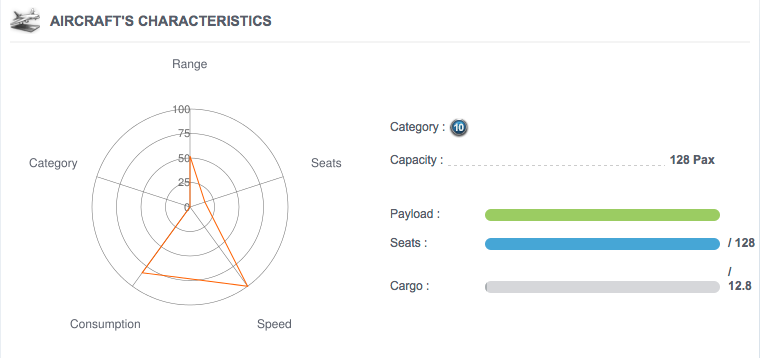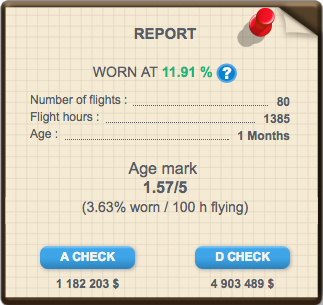This post is also available in:
 Français (French)
Français (French)  Español (Spanish)
Español (Spanish)
Aircraft management
The aircraft management page enables you to gather all your aircraft (purchased, leased and cargo aircraft) to have an overview of your fleet. If your aircraft is a lease or a cargo, a label appears on the left of the aircraft’s name as an indication.
- Range: distance that can be flown by the aircraft for a one-way flight. For example, an aircraft with a range of 1,695 km can fly on a route of 1,695 km or less.
- Use: percentage of the aircraft use according to its schedules. If the percentage is low, it means that you can certainly schedule more flights with this aircraft.
- Cargo: corresponds to the number of tonnes allocated to freight on this aircraft (the cargo transportation is only available if the corresponding research has been unlocked in the R&D).
- Seats: enables you to know the number of remaining seats and their configuration. Figures between parentheses represent each passenger class as follows: economy class / business class / first class.
- Hub: the hub to which is assigned this aircraft. It is possible to reassign the aircraft to another hub with the corresponding button in the aircraft details (see below).
- Result: net profit of flights performed by this aircraft. This is a weekly value calculated from flights over the last seven days.

Cargo aircraft
Once you have unlocked the cargo research in your Research Center (General R&D). You can use most of your current aircraft to carry goods and also purchase aircraft specially designed for freight. You can acquire these aircraft in the Cargo R&D.
These aircraft are characterized by the Cargo label and cannot transport passengers.
Lease agreements
Your leased aircraft are listed in a specific section that enables you to manage their contracts. To access this section, click on Aircraft management > Lease agreements. This list provides some information and actions to perform on the contract:
- Security deposit: amount you paid when you acquired the aircraft. The security deposit is refunded at the end if the contract.
- Cost: this amount is debited once a week to maintain your lease agreement.
- Result: net profit of flights performed by this aircraft. This is a weekly value calculated from flights over the last seven days.
- Debit: number of remaining days before your next debit. The debit is always done for the week after, which means an early termination of the lease agreement would make you lose money for the number of remaining days indicated here.
- Hub: the hub to which is assigned this aircraft. It is possible to reassign the aircraft to another hub with the corresponding button in the aircraft details (see below).
- Due date: the number of remaining days before the end of the contract. It is possible to change the due date if you want to extend or shorten the contract period of this aircraft.
The red cross displayed next to each aircraft enables you to end the contract immediately. In this case, you will be refunded the security deposit but not the days you paid in advance. You can estimate the number of “lost” days by looking at the number of remaining days before the next debit.

Pro display
- The pro display is an AM+ option that allows you to display the list of your aircraft and your lease agreements in a table format. This feature is very useful when your fleet becomes quite important.
- Example of pro display for the aircraft list:

- Example of pro display for the management of lease agreements:

- Example of pro display for cargo aircraft:
Aircraft details
The aircraft details page provides many very useful information about the management of the aircraft:
- State: the aircraft state enables you to see if repairs are required. A state of 100% means the aircraft is like new.
- Takeoff distance: precisely indicates the necessary distance so that the aircraft can to take off. In the game, the takeoff distance is also indicated by the aircraft category.
- Range: distance that can be flown by the aircraft for a one-way flight. For example, an aircraft with a range of 1,695 km can fly on a route of 1,695 km or less.
- Consommation : c’est la quantité de kérosène utilisée par cet avion pour chaque passager sur une distance de 100 miles nautiques (185 km). Plus la consommation est importante et plus vos frais de kérosène seront élevés.
- Consumption: quantity of kerosene used by the aircraft for each passenger on a distance of 100 km. The more important the consumption is, the higher your fuel costs will be.
- Speed: aircraft speed in km/h. It enables you to calculate how long the aircraft will take to fly on your route and thus a better management of your schedules. You can find more details about this calculation in the Aircraft purchase section.

The characteristics of an aircraft define its abilities:
- Category: the aircraft category is defined by its takeoff distance. An aircraft can fly on routes with a category equal or lower than the aircraft’s one. Therefore an aircraft of category 5 can fly on all routes of category 1, 2, 3, 4 or 5 but cannot fly on routes of category 6, 7, 8, 9 or 10.
- Capacity: maximum number of passengers that can be carried by this aircraft at each flight.
- Payload: the total weight an aircraft can carry. It comprises both passengers and cargo. The weight represented by a passenger is respectively 100, 130 and 150 for economy, business and first classes (the weight comprises the passenger, luggage and on-board infrastructures).
- Seats (unavailable for a cargo aircraft): indicates the number of seats and their configuration. Figures between parentheses represent each passenger class as follows: economy class / business class / first class.
- Cargo: indicates the number of tonnes allocated to freight on this aircraft. It is possible to mingle cargo with passengers (PAX) on passenger aircraft.

General information of the aircraft provide more details about your purchase and its profitability:
- Purchase date: date at which you purchased the aircraft.
- Purchase price: price at which you purchased the aircraft.
- Cumulative result: sum of profits from flights of the aircraft since its purchase.
- Profitability: percentage that represents the spreading of cost of your purchase. It is calculated by the difference between the purchase price and the cumulative result.

- Number of flights: number of flights performed by the aircraft since its purchase.
- Flight hours: number of in-flight hours performed by the aircraft since its purchase.
- Age: time since you purchased the aircraft.

Changing the hub of my aircraft
You can reassign your aircraft elsewhere if you own another hub, otherwise this action is not possible.
To change the hub of an aircraft, go the web version of the game, then go to the aircraft details section of the aircraft you want to reassign.
You will find a button to reassign your aircraft to another hub directly:

